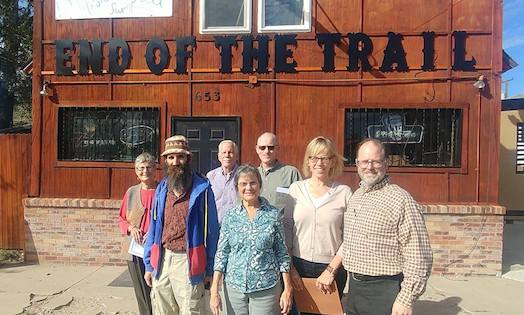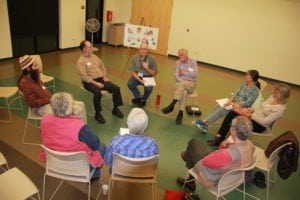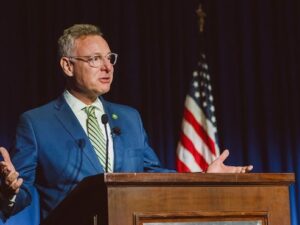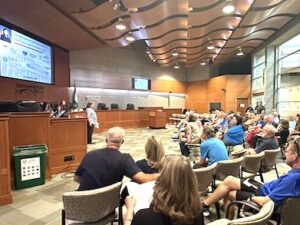
(L-R) Colorado Energy Freedom Tour volunteers Ginny Black, Trevor Stone, Bob Mayer, Cathy Casper, Bill Barron, Susan Ludwig and Thaddeus Cummins
Energy freedom for Colorado farm communities
By Cathy Casper
Colorado is best known in the nation’s mind for its mountains and ski areas. In fact, nearly half the state lies east of the Rocky Mountains, a province of the Great Plains. Denver sits at the base of this intersection of mountain and plains and, with other cities in the Front Range urban corridor, is home to nearly 90 percent of Coloradans.
Rural Colorado lies to the east of the urban corridor and contributes mightily to the state’s economy and influence. With this in mind, a band of Citizens’ Climate Lobby (CCL) volunteers set out in October to plant seeds in new terrain. They called their effort the Colorado Energy Freedom Tour. Designed to engage folks on climate policy, the team made public presentations and met with community leaders. They discussed how the people of Colorado can save jobs, increase business certainty, clean their air and manage climate risk through supporting CCL’s climate change solution. They also listened a lot.
Work began last May on the Colorado Energy Freedom Tour. An eight to 10 person planning team began with seeking to understand how to reach out to farm communities. Then the team emphasized finding local hosts, which helped in the overall success of the tour. The team started with people someone knew, but also Googled churches, read local newspapers and attended local events. They set a lot up by phone. Mostly the team found contacts through the CCL national database, but if there was no one in the database, it was a challenge to find a local person that would help. The team hoped to give the local hosts 12 weeks to do their part; in some cases, eight weeks had to suffice.
Tour planning came together and a handful of towns became tour stops, several on the edges of metropolitan Denver-Boulder, and two outlying towns: Sterling and Fort Morgan, farming towns both, plus one large city, Greeley, large enough for a university, and with a robust mining, quarrying, and oil and gas extraction industry.

Bill Barron, Cathy Casper and Bob Mayer outside the Sterling Journal-Advocate
On the surface, Sterling looked to be the toughest sell. It’s a place of 14,000 people, two hours from Denver. The local farming economy in recent decades has been augmented by jobs first at a new prison and then construction of wind turbines along the Nebraska border.
On Oct. 18, a day of sunshine, the CCL representatives arrived at the offices of Sterling’s Journal-Advocate to meet with the editor. CCL delegates took turns explaining components of Carbon Fee and Dividend and answering questions. The reporter asked sound questions. Beyond the mechanics of fee and dividend, she wanted to know: What’s in it for our community? The team let her know that every household in Logan County would get a dividend between $50 and $200 a month, depending on how the law is written.
Next up was a meeting with the president of the local community college. There were introductions all around, and it was here that Bill Barron, the Wild West regional coordinator for CCL, made a strong connection. The college president described his career, which included a stint as a sheriff’s deputy in North Dakota. Bill could identify with this. He too had been a marshal’s deputy some years before in Alta, Utah.
The meeting went well. The educator clearly wanted to be helpful, but also took the long view. When asked about possible interest on campus, he suggested that the science club members loved nature and might be open to a science lecturer. He also invited the team to return in the spring and use the theatre for the introductory presentation. The CCL volunteers promised to let him know how much of an audience showed up that evening.

Momentum picked up after Sterling with a visit to Erie, a one-time coal-mining town, now a suburb of both Boulder and Denver. There was a Saturday afternoon session in the Denver suburb of Parker where members of the outlying agricultural towns also attended. The final events were in Greeley, with a turnout of 30 people, and Fort Morgan, home to a major meatpacking plant and sugar factory.
At the end of the tour Barron flashed a smile, remembering the beginnings of CCL in Denver about five years ago. “We’ve grown so much already. The progress that we’ve made can only translate into potential everywhere.”
And seeds planted in new places can flourish, if nurtured. That’s the hard work, growing more and more support for fee and dividend in the nation’s heartland.
Cathy Casper is a retired teacher, poet and devoted planet lover who wants to leave the world a better place for her grandchildren.





